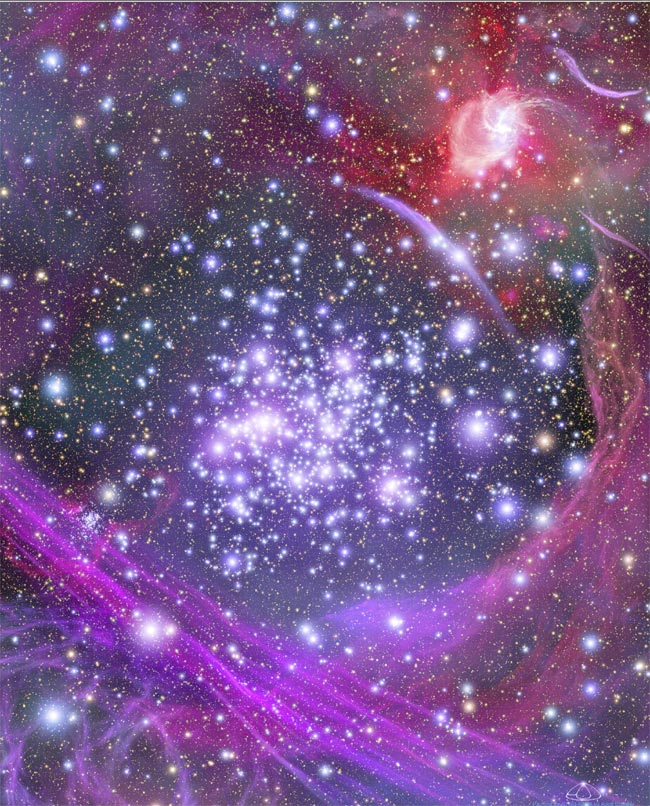Study: Stars Have a Size Limit

Astronomers announced today that stars can be born big, butonly so big.
Theories over the years have predicted that an upper limiton stellar mass existed somewhere between 10 and 1,000 times the mass of ourSun. Recent observations of a massivecluster of stars in the center of our galaxy has found that this mass cutoff isabout 150 times the Sun.
"The primary resultis that there is a cutoff. There is little uncertainty about that," said DonFiger from the Space Telescope Science Institute. "The secondary result is thatit is about 150 solar masses."
Figer used the Hubble Space Telescope to measure the massesof stars in the Arches Cluster, which is 25,000 light-years away and ten timesthe size of typical clusters in our galaxy. A cluster is a conglomeration of stars that all formed pretty much atthe same time.
"The Arches Cluster contains many more smaller mass starsthan larger mass stars. This is typicalfor a cluster," Figer said during a NASA teleconference today.
The rarity of behemoth stars is one of the reasons it hasbeen so hard to nail down an upper limit for stellar mass. But the best place to find the biggest starsis in the biggest clusters. Arches,which contains 10,000 solar masses - is our galaxy's largest known open cluster. (Note that there are larger globularclusters.)
"The richer the cluster, the more likely you are to findextremely large stars," said Sally Oey from the University of Michigan, who was not involved in Figer's research.
Breaking space news, the latest updates on rocket launches, skywatching events and more!
Oey and her collaborators have looked for the most massivestars in nine clusters of a smaller, more typical size. They were able to estimate an upper limitthat agrees with Figer's more statistically robust result.
Live fast and die young
It has long been known that a ball ofgas weighing less than about a tenth of our Sun's mass will not be able tolight the fusion reactor in its core. Once turned on, though, bigger stars burn brighter. A star 100 times more massive than the Sunwill be a million times brighter, said StanWoosley from University of California, Santa Cruz.
But these big stars burn their nuclear fuel morequickly. Stars greater than 100 solarmasses will only live about 3 million years - compared to our Sun which is expected to live for morethan 10 billion years. Therefore, to catch a glimpse of a giant star,one has to look not only at a big cluster, but a young one as well.
Fortunately, theArches Cluster is between 2 and 2.5 million years old. With Hubble's acute eye, Figer found starsthere ranging in size from 2 to 130 solar masses.
"We expected to find 20 to 30 stars with masses between130 and 1,000 solar masses," Figer said. "But we found none. If theycould have formed, we would have seen them."
If the prediction had been smaller - say, one or twobehemoth stars - then Figer could explain their absence as just bad luck. But this big of a drop-off can only beexplained by a physical barrier to more massive stars.
Limiting formation
No one is yet surewhat this physical barrier is. Woosleythought there were two likely scenarios: either something stops the star's growth early on, or the star forms,but its intense radiation causes it to blow apart.
Still, there may bestars that circumvent the 150 solar mass limit. For example, themass-spewing Pistol star may weigh as much as 200 solar masses. One way to explain this apparent paradox,Figer said, is that the Pistol star could be a "born-again" star,formed from the merger of two smaller stars. This sort of formation mechanism would be very unusual, however.
"There is no starin the galaxy that credibly breaks the 150 solar mass limit," Figer said.

Michael Schirber is a freelance writer based in Lyons, France who began writing for Space.com and Live Science in 2004 . He's covered a wide range of topics for Space.com and Live Science, from the origin of life to the physics of NASCAR driving. He also authored a long series of articles about environmental technology. Michael earned a Ph.D. in astrophysics from Ohio State University while studying quasars and the ultraviolet background. Over the years, Michael has also written for Science, Physics World, and New Scientist, most recently as a corresponding editor for Physics.
